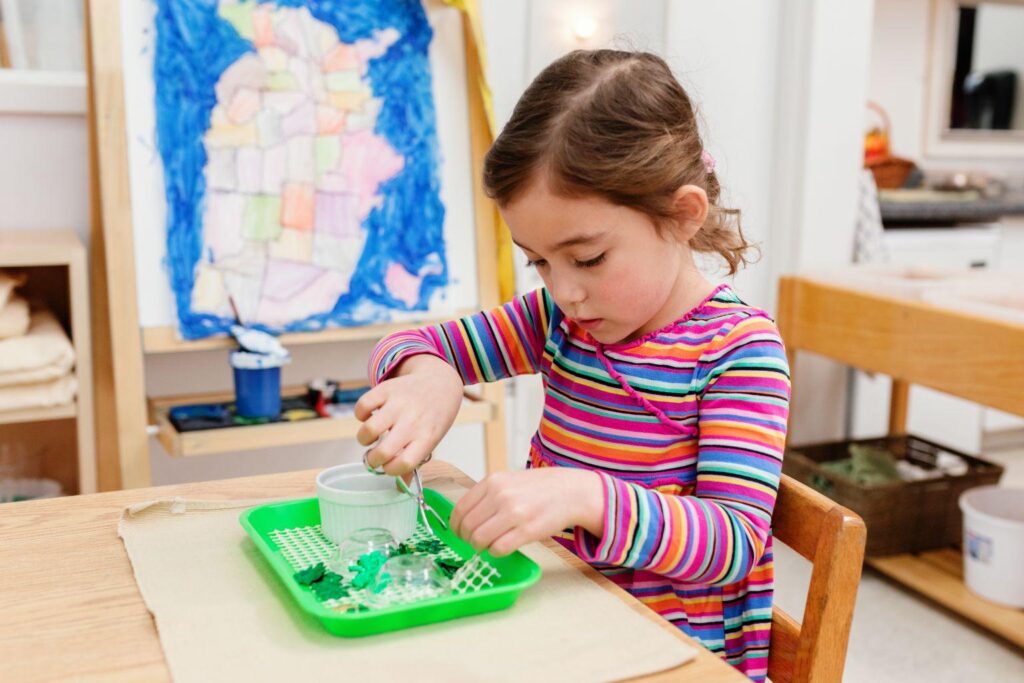If you’ve ever raised a toddler, you’ve likely encountered that particularly difficult stage where they throw everything they can get their hands on. It doesn’t matter if it’s a sock, a book, or a plate of spaghetti. If your toddler can pick it up, it’s flying through the air within seconds. Most Montessori parents understand that this is developmentally normal and nothing to be alarmed by, but what if I told you that this type of behavior is not only harmless, it’s actually extremely important work?
When children display repetitive behaviors like throwing, they are developing something called a play schema. Play schemas are how children learn about the world around them and develop essential tools for interacting with that world.
Let’s learn more about why play schemas are important and how to identify and encourage your child as they learn through play!
Why Are Play Schemas Important?
While some people might believe that children learn only what they are taught, this couldn’t be further from the truth! From the moment they’re born, children are learning constantly!
Think about it this way: Do you remember the moment when you learned how to hold an egg firmly enough that you don’t drop it but gently enough that it doesn’t break? Probably not, or – if you did – it’s likely because an adult told you to “be gentle” or “don’t squeeze it too hard.” But when did you learn what gentle means, what it feels like? When did you learn the outcomes of holding onto something too hard, too soft, or just hard enough?
This is what children are learning when they develop play schemas. They are not taught these concepts by anyone; they learn them through doing instead. The earliest version of what they will later come to know as “trial and error,” “cause and effect,” and even “the scientific method.” On a certain level, play schemas are like a child’s first physics lesson – a way for them to explore and learn about the world’s rules and processes.
The term “play schema” was coined by Swiss psychologist Jean Piaget. Piaget, who theorized that children’s minds work differently than adults, found that children used repetitive activities as a way to learn about the world around them and how to operate within that world, almost like these play behaviors were practice or training for later adult behaviors.
If children do not develop play schemas, then the world becomes an incomprehensible place. They have no way to predict the result of even the smallest action or decision. They have no understanding of who they are or what’s happening around them. That sounds pretty scary! Thankfully, children are seemingly hardwired to develop play schemas all on their own, regardless of any outside factors!
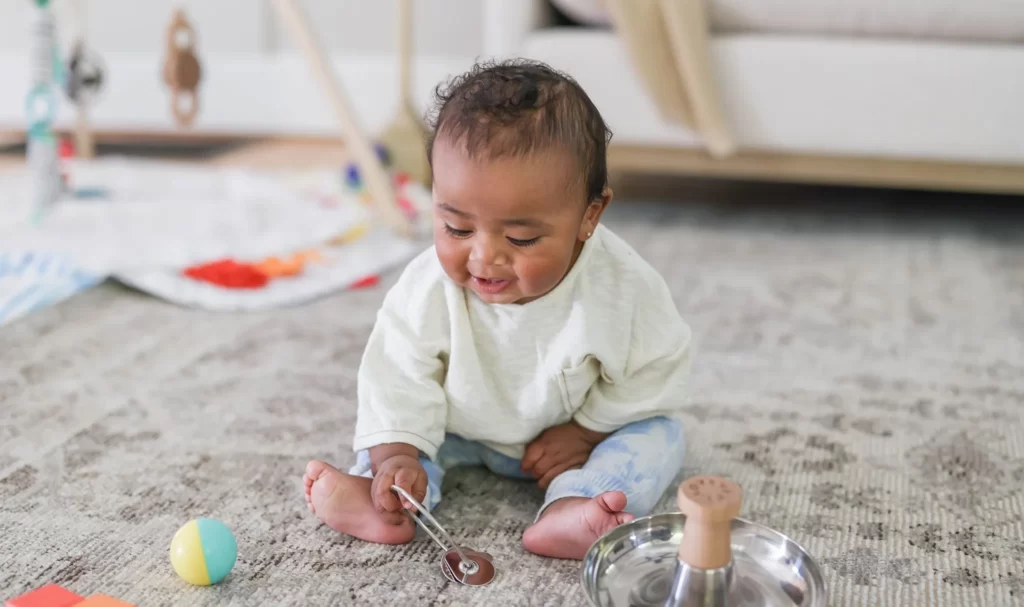
When Do Play Schemas Develop?
The moment a child is born, they possess only the most basic reflexes and instincts. Everything else has to be learned!
Since babies are undergoing incredibly rapid physical and sensory development, most play schemas tend to emerge later. However, even young infants show some initial signs of schema development. For instance, when babies grab their parent’s hand or play peekaboo, they are in the earliest stages of the schema for Enveloping (more on this later!)
The toddler years are when most schemas tend to emerge and become the most prominent. There’s a reason toddlers are so busy all the time! This stage of rapid schema development tends to last for a few years, but play schemas are a life-long developmental tool.
Even adults sometimes use play schemas when encountering something novel. This is how we learn about new games, new devices, new technologies, and more! It’s also important to remember that – while many children will begin developing play schemas around the same time, there’s no set timeline or “right track” for developing these schemas and all children develop at their own unique pace!
So, now that we know a bit more about why play schemas are important, let’s explore the types of play schemas and think about how we can encourage our children as they develop these essential skills.
How to Identify and Encourage Play Schemas
There are countless play schemas, but many of them can be categorized within 9 basic types. Each type is connected to an important set of skills that the child is learning while engaging in this type of play.
Let’s explore!
Trajectory Schema
Going back to our original example, Trajectory is all about gravity and force. In other words: throwing! Of course, it’s not just throwing. It’s also dropping, rolling, pushing, falling, and other activities that explore what happens when the child transfers force onto another object. A child engaging in play to develop this schema is figuring out what makes things move, which will lead to a basic intuitive understanding of gravity and force.
What does the trajectory play schema look like in action?
- Dropping food off a high chair.
- Throwing toys.
- Kicking, pushing, and hitting.
- Jumping off of things.
- Pushing furniture around.
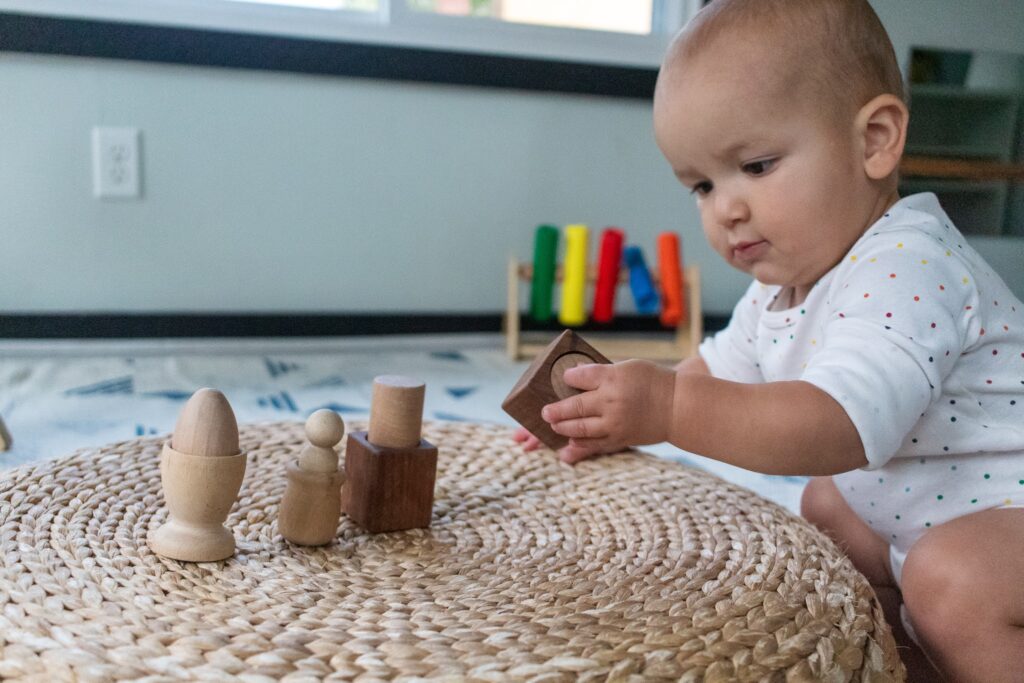
How can you support the trajectory play schema?
It can be particularly helpful for parents and caregivers to support the Trajectory schema, as children developing this schema often engage in risky behaviors or behaviors that could be misinterpreted as violent. Here are some safe, productive strategies for helping your child continue to develop an understanding of Trajectory:
- Set up sensory activities with water, allowing your child to play with running water and explore what happens when water moves from a higher to a lower elevation.
- Find soft balls for your child to use to roll, kick, and bounce.
- Have your child play with car or train toys that they can roll down ramps, tracks, and hills.
- Set up target practice with safe projectile toys.
- Play with scarves and ribbons in the wind.
- Play catch!
- Find child-safe and child-appropriate tools that your child can use to hammer, hit, and chop.
Connection Schema
Connecting is all about joining things together and taking them apart. There are many different ways to connect objects! They can be connected using simple gravity and friction, like with building, stacking, or joining; they can be connected through magnetic force; they can also be connected through tying, taping, and pasting. And disconnecting is just as important, as children explore the steps of taking something apart. This schema builds an understanding of magnetic force, friction, stickiness, part-to-whole relationships, and structure.
What does the connection play schema look like in action?
- Banging blocks together.
- Building towers out of toys.
- Knocking down towers and structures.
- Pulling buttons off of clothes.
- Pulling off diapers or other clothes.
- Playing with string and tape.
- Playing with sticky substances.
How can you support the connection play schema?
- Do arts and crafts that involve pasting or taping.
- Make bracelets or other beaded crafts.
- Build towers. Then, knock them down!
- Play with Legos or other connecting toys.
- Hold hands!
- Play with toys that have clips or snaps.
- Play with clay and dough.
- Use puzzles and stacking toys.
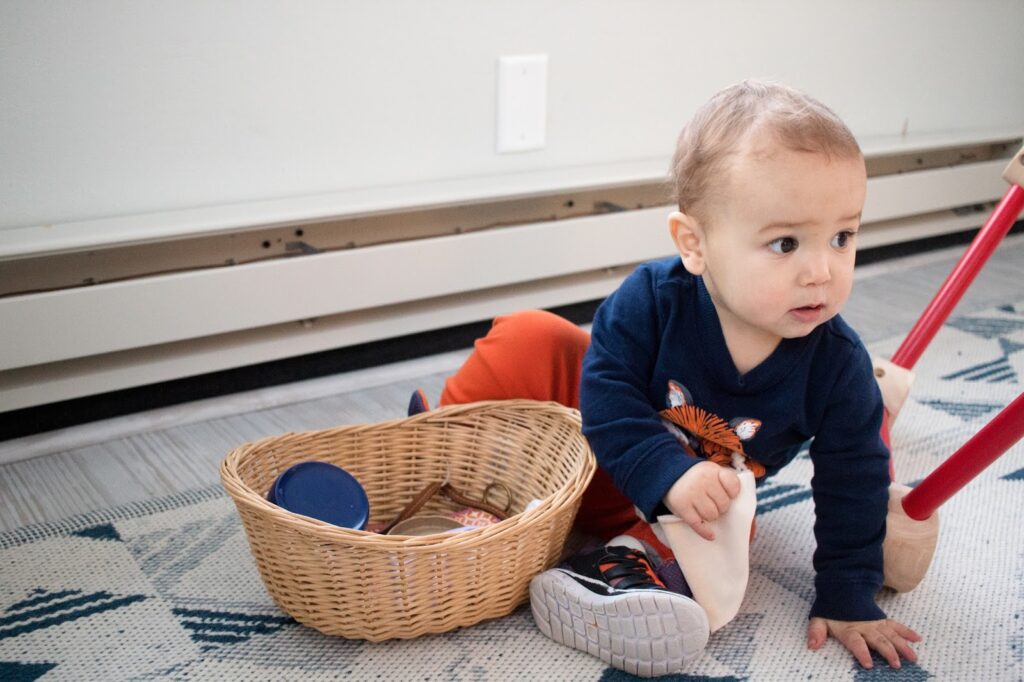
Transforming Schema
Transforming is all about how things change! Children developing their Transforming schema are exploring changes in structure, composition, and appearance. This could be observing and creating simple chemical transformations, combining substances together, mixing colors, playing with clothes and hair, or mixing foods. This schema builds an understanding of chemistry, states of matter, materials, substances, and change.
What does the transforming play schema look like in action?
- Playing with food.
- Playing dress-up.
- Children drawing on themselves or others.
- Mixing paints together
- Playing with substances like water, sand, ice, snow, and clay.
How can you support the transforming play schema?
- Mix paints together to explore the color wheel.
- Create oobleck and slime.
- Bake and cook together!
- Sensory activities with sand, water, clay, and other materials.
- Make potions and substances using different (safe) household materials.
- Play dress-up.
- Face-painting.
Orientation Schema
Orientation is all about perspective and vantage point. Children developing the Orientation schema are exploring what the world looks like from all different angles! This could mean moving their bodies to see something differently, moving the object itself, or visualizing a different facet of something. This schema builds an understanding of perspective, point of view, spatial reasoning and language, directions, body awareness, and gross motor skills.
What does the orientation schema look like in action?
- Hanging upside-down.
- Climbing furniture.
- Hiding under furniture.
- Running up and down hills or structures.
- Turning books upside down.
- Twisting toys to see them at different angles.
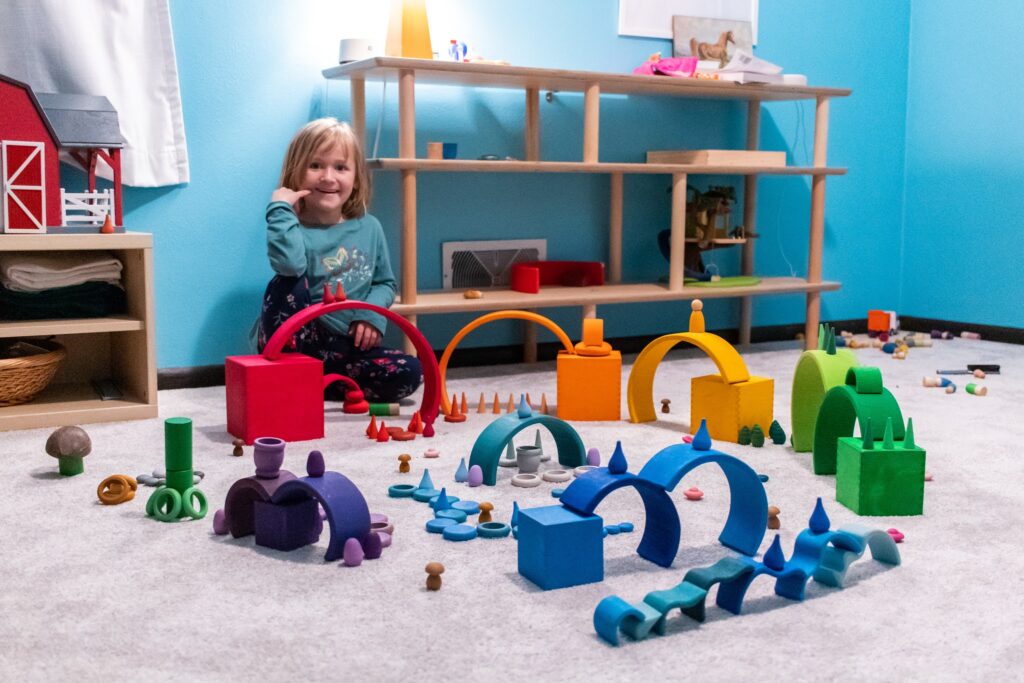
How can you support the orientation play schema?
- Swinging, rocking, and spinning.
- Playing with binoculars and magnifying glasses.
- Hiking and caving.
- Provide spatial language like “over, under, within, outside, between, etc.”
- Sculpting and drawing objects in three dimensions.
- Lots of outside time to explore!
Rotation Schema
Rotation is all about things that turn and spin! Children developing their Rotation schema are exploring circular motion. This could be circular motion with their bodies or circular motion created by objects like wheels, fans, tops, and hoops. This schema builds an understanding of rotation, symmetry, simple machines, and balance.
What does the rotation play schema look like in action?
- Spinning in circles.
- A fascination with the washing machine or dryer.
- Turning the taps on and off.
- Rolling down a hill.
- An interest in wheels and fans.
How can you support the rotation play schema?
- Buy or make pinwheels.
- Play with hula hoops.
- Any toys with wheels.
- Churning butter or making food using a stand mixer.
- Using screws and drills (with supervision or with child-friendly versions.)
- Gymnastics, ice-skating, and dance.
Enveloping Schema
Enveloping is all about hiding, wrapping, and covering! Children developing their Enveloping schema are exploring what it means to hide or enclose something. This could mean shielding something from view, wrapping something up, or putting things inside other objects. This schema builds an understanding of object permanence, part-to-whole relationships, and spatial orientation.
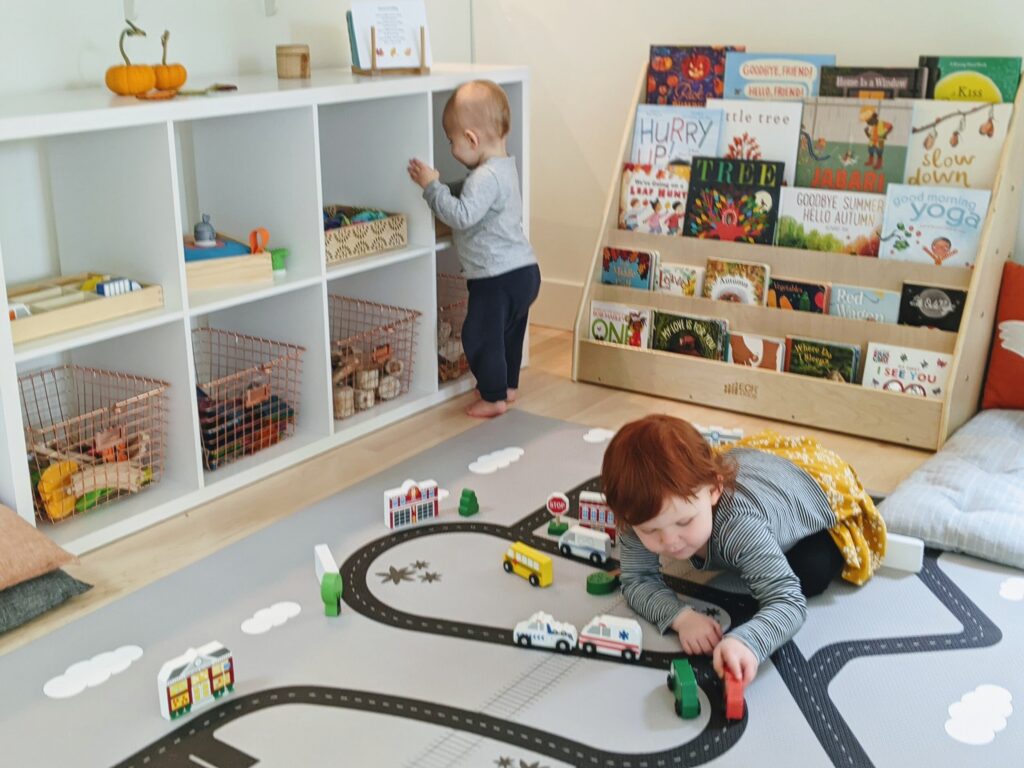
What does the enveloping play schema look like in action?
- Hiding objects around the house.
- Hiding.
- Dropping objects in hard to reach places.
- Covering things up with blankets or curtains.
- Draping fabric.
- Stacking pots and pans or mixing bowls inside of each other.
- Putting objects inside their clothes.
How can you support the enveloping play schema?
- Play hide and seek!
- Wrap presents and cards together to send in the mail.
- Play with puppets.
- Make masks and costumes.
- Playing with nesting dolls or nesting boxes.
- Make a secret fort!
Enclosing Schema
Enclosing is very similar to Enveloping but with a distinct difference: while Enveloping is all about hiding and containing, Enclosing is all about creating boundaries and barriers. Children developing their Enclosing schema are exploring real and imaginary boundaries. These could be boundaries created by fences, gates, borders, cages, bodies of water, or even invisible barriers. This schema builds an understanding of boundaries, barriers, personal space, and location.
What does the enclosing play schema look like in action?
- Creating a barrier around themselves using toys or other objects.
- Climbing into boxes or other tight spaces.
- Requesting that special toys or keepsakes are “kept safe” in a special place.
- Drawing barriers and boundaries around artwork.
- Running in circles around objects.
How can you support the enclosing play schema?
- Drawing, particularly spirals, faces, and enclosed spaces.
- Helping build fencing and containers.
- Creating a special box for keepsakes.
- Putting away groceries, dishes, and toys.
- Building sand castles with moats.
- Building forts and dollhouses.
Positioning Schema
Positioning is all about grouping, sorting, and organization. Children developing their Positioning schema will show an interest in lining up or positioning objects just so. This could look like lining objects up by size, sorting things by color, collecting items by group, or having particular places where different toys and objects belong. This schema builds an understanding of organization, grouping, sorting, and identifying patterns.

What does the positioning play schema look like in action?
- Lining up toys by size, color, or a different organizing factor.
- Collecting types of objects like rocks or leaves.
- Setting up toys just so.
- Straightening or sorting lines of objects.
- Rearranging toys or objects within the home.
- Sorting food by color, flavor, or texture.
How can you support the positioning play schema?
- Collecting objects together.
- Go hunting for shells or sea glass at the beach.
- Sort things by color or size.
- Create mandalas.
- Play with puzzles.
- Have your child prep for meals by retrieving and sorting the ingredients.
- Have your child tidy their bedroom or playroom.
- Put away groceries or dishes.
- Let your child choose their own outfits by setting them out the night before.
Transporting Schema
Transporting is all about moving things from one place to another. Children developing their Transporting schema are interested in how things get from point A to point B. This could be an exploration of how they move their own bodies, how they can carry and move items, or machines that are designed for transport like cars and planes. This schema builds an understanding of object permanence, spatial awareness, containers, and movement.
What does the transporting play schema look like in action?
- Carrying toys from one side of the room to the other.
- Bringing you items and then taking them back.
- An interest in transportation machines like cars, trucks, planes, and boats.
- Pushing strollers and carts.
- Putting things in their pockets.
How can you support the transporting play schema?
- Let your child use a child-sized cart for grocery shopping.
- Have your child decide what they want to pack in their backpack each day.
- Take a bus ride around your city or town.
- Buy pusher toys like toy lawn mowers and vacuum cleaners.
- Bikes, tricycles, and wagons.
- Go berry-picking with a child-sized basket.
- Have a cart or basket to help with clean up time.
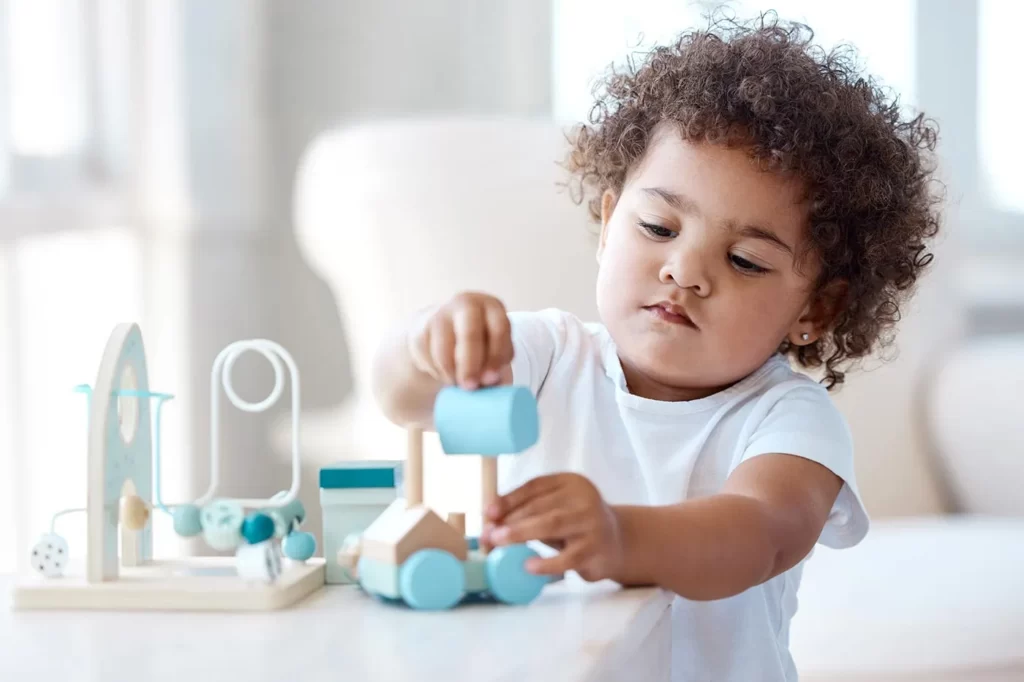
How Do Play Schemas Connect to Montessori?
Montessori is all about intentionally crafting an environment that supports your child’s independent learning and development. Understanding play schemas is crucial to being able to do so!
Play schemas can help parents reach a deeper level of understanding of the core tenets of the Montessori philosophy:
- Play schemas allow parents to better understand some of the motivations behind children’s actions and instincts, which can help them have Respect for the Child.
- Play schemas demonstrate how children are born full of an endless capacity for learning and knowledge, which is helpful for understanding the idea of The Absorbent Mind.
- Identifying behaviors aligned with different play schemas can help parents determine Sensitive Periods, times when children are ready to learn new skills or take in new information.
- Play schemas connect to specific repeated actions and interests, which can help parents design a Prepared Environment.
- Play schemas develop naturally and children engage independently in behaviors that build these schemas, which is exactly aligned to the Montessori principle of Auto Education.
Regardless of what they are being taught, children are always naturally learning and growing more than we even think possible. Now that you know more about play schemas, see if you can determine which new schemas your child has been developing lately!
